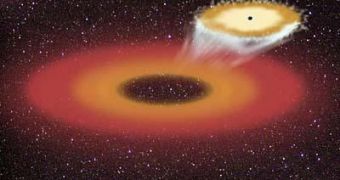In Cosmos, the most coveted commodity is hydrogen, a gas that galaxies can use for building stars. A new study made on data offered by NASA's Spitzer Space Telescope uncovered a distant, massive galaxy burglar while stealing huge gas amounts, about the quantity comprised by one billion suns, from its smaller neighbor galaxy. The loot will later transform into new stars and planets.
"We may be viewing the larger galaxy in a rare, brief stage of its reincarnation from an old galaxy to a youthful one studded with brilliant stars," said lead author Patrick Ogle of NASA's Spitzer Science Center at the California Institute of Technology, Pasadena, Calif.
The cosmic thief, named 3C 326 North, is similar in size to our Milky Way galaxy, while the victim, 3C 326 South, has 50 % of its mass. The galaxies are located closely enough to induce gravitational attraction to each other and eventually crash.
Merger galaxies are known: gas and stars coming from both galaxies turn so entangled that at a point a difference cannot be made on the origin of the galactic corpses. 3C 326 is the best case yet of huge gas amounts being warmed and swallowed by one galaxy from another.
"This could be an important phase in galaxy mergers that we are just now witnessing," said Ogle.
The team initially focused on a set of remote galaxies (radio galaxies), located about one billion light-years away. These galaxies expel radio-emitting jets that display their central black holes.
The jets are strong, while the quiet black holes do not expel too much energy. The team investigating 72 galaxies with Spitzer's infrared vision detected a handful of unusual ones. 3C 326 North was the strangest: it was sucking in a huge quantity of hot hydrogen gas, up to 730 ?C (1,340 ?F).
Hydrogen is normally invisible to optical telescopes, but when heated up it shines at infrared wavelengths.
"Hydrogen is by far the predominant element in the universe, yet in its molecular form it has been virtually undetectable until Spitzer launched," said co-author Robert Antonucci of the University of California, Santa Barbara.
Spitzer images revealed a tail of stars, named a tidal tail, linking 3C 326 North to 3C 326 South, the clue betraying the theft.
"The galaxy in question appears to be stripping a large quantity of molecular hydrogen from its neighbor and heating it up. The supermassive black hole at the center of the galaxy is digesting a small fraction of the gas and ejecting it in enormous, relativistic jets millions of light-years long." said Ogle.
Once hydrogen has cooled down enough, it builds new stars and planets. And what about the victim? Fuel shortage will prevent it from forming new stars, but if the two neighbors merge, then they will share all the belongings. The previously stolen ones included.

 14 DAY TRIAL //
14 DAY TRIAL //